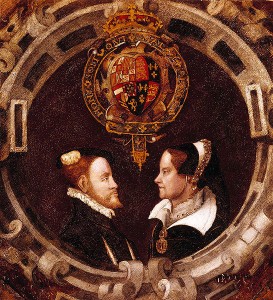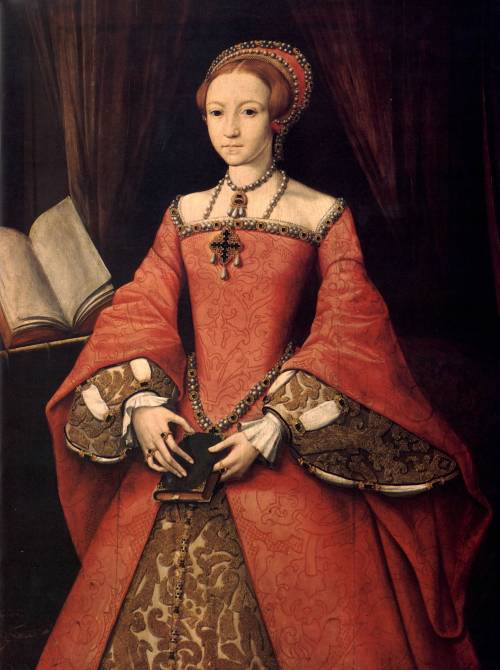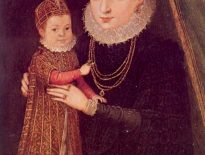 On this day in history, 25th July 1554, the feast day of St James, thirty-eight-year-old Queen Mary I married twenty-seven-year-old Philip of Spain, son of Charles V, Holy Roman Emperor, at Winchester Cathedral. Stephen Gardiner, Bishop of Winchester and Mary's chancellor, officiated.
On this day in history, 25th July 1554, the feast day of St James, thirty-eight-year-old Queen Mary I married twenty-seven-year-old Philip of Spain, son of Charles V, Holy Roman Emperor, at Winchester Cathedral. Stephen Gardiner, Bishop of Winchester and Mary's chancellor, officiated.
There is an account of the wedding in Charles Wriothesley's A chronicle of England during the reigns of the Tudors, from A.D. 1485 to 1559:
"The 25 of Julie, beinge Weddensdaye and St. James daye, about xi of the clocke the Kinge and Queene came from their lodgings towardes the churche all the way on foote, verie richelye apparelled in gownes of cloth of golde sett with riche stones, he with his gentlemen and garde and she with hers, eche of them havinge a sworde borne before them, the Earle of Darbye bearinge the sworde before her Maiestie, and the Earle of Pembroke before the Kinge; and when they were come into the churche he went into one traveys and the Queen to another richlye hunge, where they were shriven. This done they came forth of their traveys to the place appoynted for the marriage, where the Lord Chauncellor, beinge before with 5 other bishops assistinge him, used all thinges, both in the banes-byddinge and otherwise, as hath bene in all marriages of olde tyme, and spake it both in Latin and in Englishe, her Grace on the right syde standinge and the King on the left syde. Her marriage ringe was a rownd hoope of gould without anye stone, which was her desire, for she sayde she would be married as maydens were in the olde tyme, and so she was.
After the marriage knott thus knitt the King and Queen came hand in hand under a riche canopie, beinge borne over them with 6 knightes and 2 swordes before them, all the lordes both Englishe and strangers richelye apparelled goeinge afore them, the trumpetts then blowinge tyll they came into the quier, where all the priestes and singinge men all in riche copes began to singe a psalme used in marriages, the King and Queen kneelinge awhile before the aulter, eche of them havinge a taper afore them; then after her Majestic went into her traveys on the right syde, and the King into another on the left syde; after the gospell they came owt and kneeled before the alter openlye all the masse tyme, and the care-cloth was holden ouer them; and he kissed the bishopp at the Agnus and then her Majestic. The masse done the Kinge of Herroldes openlye in the churche, and in presence of the King, the Queen, the lordes and ladies, and all the people, solemnlye proclaymed their Maiesties Kinge and Queene, with their title and style, in manner as followeth:
Philippe and Marie, by the grace of God Kinge and Queene of Englande, France, Naples, Jerusalem, and Irelande, Defenders of the Faythe, Princes of Spayne and Sicilie, Archdukes of Austriche, Dukes of Mylane, Burgundye, and Brabant, Countes of Aspurge, Flaunders, and Tyrrole. Which proclamation ended, the trumpetts blue and other noyses playde. And then the Kinge and Queene came furthe hand in hand, with their lordes, ladies, and gentlemen waytinge on them, and 2 swordes borne afore them in manner aforesaid; and so went on foote to the courte, and there dined openlye in the hall, both together at one table."
And here's another account, this time from The Chronicle of Queen Jane and of Two Years of Queen Mary, and especially of the Rebellion of Sir Thomas Wyatt, written by a Resident in the Tower of London:
"On wensday the 25th of July, being St. James's day, the prince, richly apparelled in cloth of gold, embroidered, with a great company of the nobles of Spayne, in such sort as the like hath not been seen, proceded to the church, and entered in at the west door, and passed to his traverse, all the way on foot; and to the church he had no sword borne before him.
Then came the queenes majesty, accompanied with a great number of the nobility of the realm, the sword being borne before her by the earl of Derby, and a great company of ladyes and gentlewomen very richly apparelled: her majesty's train was borne up by the marquesse of Winchester, assisted by sir John Gage her lord chamberlayne: and so she proceeded to the church; the kinges and herauldes of arms in their coates going before her from her lodging on foot to the church, where entering at the west door she passed on till she came to her traverse. Then the bishop of Winchester, lord chancellor of England, which did the divine service, assisted by the bishops of London, Duresme, Chichester, Lyncoln, and Ely, all with their crosiers borne before them, came out of the quier to the mount.
Then came the regent Figirola, whose name was (blank) and presented to the prince a solemn oration with a patent sent from the emperor to the prince, of the surrender of the kingdom of Naples, freely given to him and his heirs, as by the said patent was declared; which patent was fair sealed and inclosed in a cover of silver gilt. This done, the lord chamberlayn made a goodly oration to the people, which was in effect as followeth:
Whereas the emperor, bv his embassadors here in England, hath concluded and contracted a marriage between the queen's majesty and his chief jewell and son and heir Philip prince of Spain, here present, the articles whereof are not unknowen to the whole realme, and confirmed by act of parliament, so that there needeth no further rehearsall of that matter, &c. and so like-wise declared that the queenes highness had sent the earl of Bedford and the lord Fitzwater embassadores unto the realme of Spain, for the performing of the said contract, which they have here brought, with the consent of the whole realme of Spayne, for the full conclusion of the same, as may appear by this instrument in parchment, sealed with a great seal, containing by estimation 12 leaves.
Then the lord chamberlayn delivered openly for the solemnification of their highness' marriage, how that the emperor had given unto his son the kingdom of Naples. So that it was thought the queen's majesty should marry but with a prince, now it was manifested that she should marry with a king; and so proceeded to the espousals: and with a loud voice said that, if there be any man that knoweth any lawful impediment between these two parties, that they should not go together according to the contract concluded between both realmes, that then they should come forth, and they should be heard; or else to proceed to celebration of the said marriage, which was pronounced in English and Latin: and when-it came to the gift of the queen it was asked who should give her. Then the marquess of Winchester, the earles of Derby, Bedford, and Pembroke, gave her highness, in the name of the whole realm.
Then all the people gave a great shout, praying God to send them joy; and, the ring being laid upon the book to be hallowed, the prince laid also upon the said book iij. hand-fulls of fine gold; which the lady Margaret seeing, opened the queen's purse, and the queen smilingly put up in the same purse. And when they had inclosed their hands, immediately the sword was advanced before the king, by the earl of Pembroke.
This done, the trumpetes sounded ; and thus both returned hand in hand, the sword being borne before them, to their traverses in the quier, the queen going always on the right hand, and there remained until mass was done; at which time wine and sops were hallowed, and gave unto them; and immediately after, Garter king of arms, with the other kinges and herauldes, published and proclaimed their titles in Latin, French, and English; and so they returned to the bishop's palace both under one canopy, bom by vij. knightes, the queen on the right hand, and their swordes borne before them; and so proceeded to the hall, where they both dined under one cloth of estate."
The next day, Mary wrote to Philip's father, the emperor:
"I hear that the King, my husband, is sending Count Hoorn to report to your Majesty that he has arrived in this kingdom and that the marriage between us two was celebrated on St. James's day (i.e. July 25th). I do not wish to let Count Hoorn go without praying him to tell your Majesty how happy the arrival of his Highness has made me, and present to you my humble commendations and thanks for allying me with a Prince so full of virtues that the realm's honour and tranquillity will certainly be thereby increased, assuring you that I will take pains to serve you in gratitude, and report to you from time to time the happy progress of affairs. In order to avoid repetition, I will beg your Majesty to give credence to Count Hoorn, who is to recite to you that which his Highness has imparted to him."
It sounds like she was very happy with her new husband.
25th July is the Feast of St James the Great and the Feast of St Christopher - click here to find out more on our July feast days page.
Notes and Sources
- Wriothesley, Charles (1875) A chronicle of England during the reigns of the Tudors, from A.D. 1485 to 1559, Volume II, Camden Society, p. 120. Read online at https://archive.org/details/chronicleofengla02wriouoft
- ed. Gough Nichols, John (1850) The Chronicle of Queen Jane and of Two Years of Queen Mary, and especially of the Rebellion of Sir Thomas Wyatt, written by a Resident in the Tower of London, Camden Society, p167-170. This can be read online at http://openlibrary.org/books/OL13503895M/The_chronicle_of_Queen_Jane
- 'Spain: July 1554, 16-31', in Calendar of State Papers, Spain, Volume 12, 1554, ed. Royall Tyler (London, 1949), pp. 312-322. British History Online http://www.british-history.ac.uk/cal-state-papers/spain/vol12/pp312-322, Mary I to the Emperor, 26 July, 1554.



I am curious about the painting. Is it a wall display or a plate or a tapestry. It looks to be painted on wood so a panel perhaps? Just very curious as I have seen it but don’t know who painted it.
Thanks.
It’s an oil painting (on panel) and the artist is unknown. See https://commons.wikimedia.org/wiki/File:Philip_and_Mary_I_(reigned_1553-1558)_by_English_School.jpg.